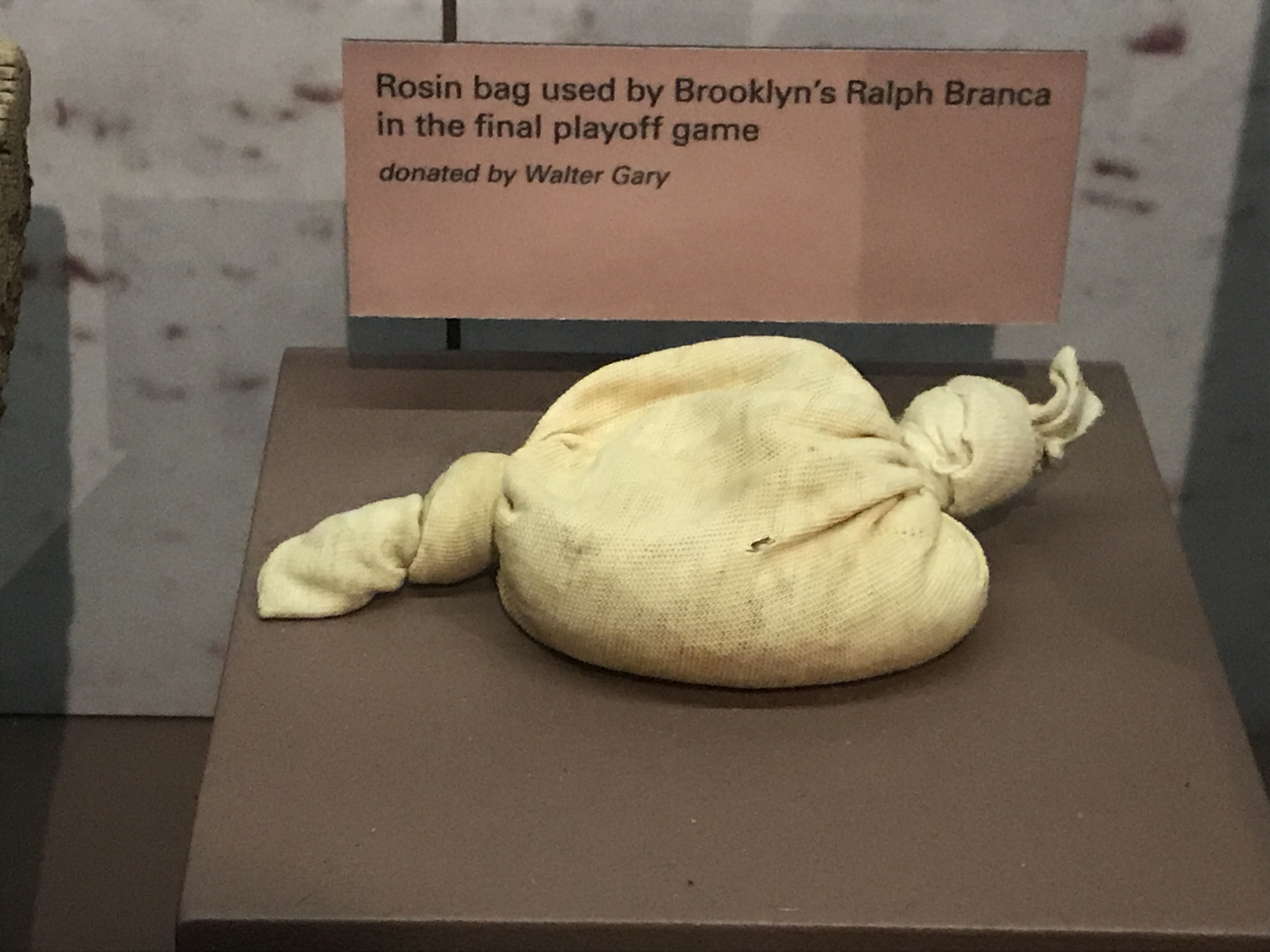
A totem of things gone wrong. (Photo by Jon Weisman at the National Baseball Hall of Fame in Cooperstown, July 14, 2019.)
In an ongoing Twitter thread, I have been tracking the potential 2020 National League postseason matchups on a nightly basis. Remember — this year, eight teams from each league will make the playoffs, which will open with best-of-three series that aren’t quite sudden death but close enough.
The three division winners are seeded No. 1-3 no matter what, followed next by the three second-place teams, then finally by the teams with the next-best records, regardless of division. By some margin the best first-place and second-place teams in the NL, the Dodgers (No. 1) and the Padres (No. 4) have been locked into their seeds for quite some time. But the other six seeds have been flopping teams like fish on a sidewalk.
In announcing this format for 2020, MLB made it clear there will be no tiebreaker games, instead setting out a set of tiebreaker rules. On the final night of August, we got a glimpse of just how crazy things could get.
First, here are the winning percentages of the top eight teams if the season were already over.
- .722 Dodgers
- .595 Padres (second-place team, no higher than No. 4 seed)
- .588 Braves, Cubs
- .500 Cardinals, Marlins, Phillies
- .486 Rockies
Notice anything? Ties, ties, almost nothing but ties. While it’s obviously unlikely that these ties would happen to fall on the final day of the season September 27, it’s not implausible. In fact, given how close the Rockies, Giants (17-19) and Brewers (16-18) are, we could have even more ties. And those ties could make a heck of a difference in setting up those first-round postseason matchups.
(By the way, you might have heard a rumor in July that division winners would get to choose their first-round opponents. However, that never was enacted. In fact, MLB is even contemplating putting the playoffs in a pandemic bubble that would eliminate home-field advantage for the top teams.)
So here’s how the ties get broken, according to the powers that be.
All ties will be resolved mathematically. No additional games will be played to break any ties. … The first tiebreaker is head-to-head record (if applicable). If that’s also a tie, the next tiebreaker is intradivision record. If that’s still a tie, the next is record in the final 20 division games (plus one until the tie is broken).
So, let’s look at the Braves and the Cubs. Because teams are not playing against other NL opponents outside their division this year, they have no head-to-head record. That means we move to intradivision record. Guess what? Chicago and Atlanta are both 13-9 in their division.
If that’s still a tie, the next is record in the final 20 division games.
Yep, you know it. The Cubs and Braves are both 12-8 in their most recent 20 games.
But we do have a way to split them, because in their 21st most recent intradivisional game, the Braves won, while the Cubs lost. So the Braves currently sit as the No. 2 seed.
(Let’s not talk about the inherent unfairness of a rule that ignores the relative strengths of the two divisions. If you’re looking for fairness, 2020 ain’t bringing it.)
That moves us down to the lower seeds, where the Cardinals, Marlins and Phillies all have .500 records. Sorry if I’m the one to break it to you, but we are facing an NL postseason where as many as four teams won’t have winning records. So how does that three-way tie get broken?
First, the tie within the NL East between the Marlins and Phillies would have to be settled. Currently, the Marlins have a 2-1 edge there, so they earn second place. But hey, their fun’s not done — those two teams will play each other seven times in five days from September 10-14.
For now, that puts the Marlins up against the Cardinals for the No. 5 seed in the NL bracket. Because the Cardinals are 8-7 in the NL Central, compared to the Marlins’ 10-11 ledger in the NL East, St. Louis grabs the No. 5 seed, at least for a day.
And that leaves us with these current matchups:
- 1) Dodgers (26-10, .722) vs. 8) Rockies (17-18, .486)
- 2) Braves (20-14, .588) vs. 7) Phillies (15-15, .500)
- 3) Cubs (20-14, .588) vs. 6) Marlins (15-15, .500)
- 4) Padres (21-15, .595) vs. 5) Cardinals (13-13, .500)
But here’s another twist. Because the Padres — who reloaded in a big way at Monday’s trade deadline — are practically locked into the No. 4 seed, getting the No. 5 seed might be a booby prize. Or if the Padres make a big run in September, it could be the Dodgers in that No. 4 seed. Maybe we’re splitting hairs here, but you tell me if you’d rather be a No. 5 seed playing one of the Southern California juggernauts or a No. 6 seed playing the Cubs in October.
It’s hard to know if it will be this crazy when the season ends, but don’t say I didn’t warn you …




Comments are closed.